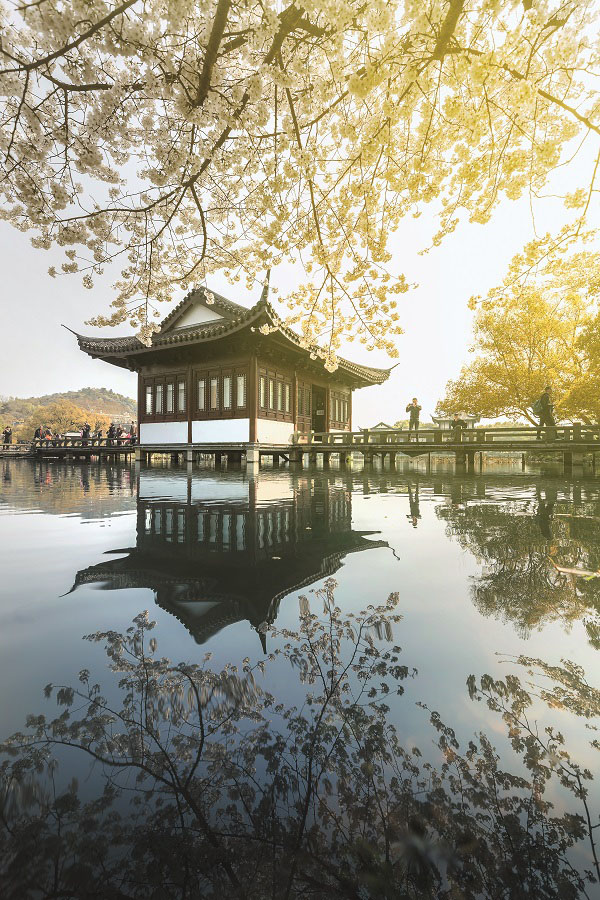Rising Tide of the Times: Hangzhou’s Ageless Allure

Nearly a millennium ago during the Yuan Dynasty (1271-1368), a Venetian traveler named Marco Polo found his way to the enchanting embrace of Hangzhou, capital of eastern China’s Zhejiang Province.
Its splendor unfolded before the European as a tapestry of artistry. He described a myriad of 12,000 bridges, large and small, and 3,000 bathhouses adorning its cityscape. The residents of Hangzhou, adorned in elegance, adopted a peaceful way of life and dwelt in architectural wonders embellished with carved beams and painted rafters. The opulence and grandeur of the Far Eastern metropolis left Marco Polo in a state of wondrous awe, compelling him to dub Hangzhou “the city of unmatched beauty and luxury on Earth.”

From the day the first settlers began inhabiting the locale, ancestors of today’s Hangzhou fostered a flux of fortune. A saga unfolded in the Spring and Autumn Period (770-476 B.C.) when it was governed by the Yue Kingdom before metamorphosing into part of the Chu Kingdom in the Warring States Period (475-221 B.C.). When the Qin Dynasty (221-207 B.C.) united China, Qiantang County was first defined. By the Sui Dynasty (581-618), Qiantang was flourishing and evolving into Hangzhou’s administrative heart. In the Five Dynasties and Ten Kingdoms era (907-979), Qian Liu, founder and first ruler of the Wuyue Kingdom (907-978), transformed it into a renowned city in the region. During the Southern Song Dynasty (1127-1279), it expanded into a vibrant imperial capital.
Hangzhou’s fusion of natural allure and cultural heritage across 3,000 years remains unmatched. A symphony of praise has been composed by literati from every dynasty, especially the Tang Dynasty (618-907), casting a poetic spell over it.
The Tang Poetry Road of eastern Zhejiang, a historical route arguably as important as the Silk Road and the Tea Horse Road, begins in present-day Xiaoshan District of Hangzhou. During the Tang Dynasty, more than 400 poets inscribed over 1,500 odes to Hangzhou. Writers from across the country leveraged Hangzhou’s charm as a muse. Their verses paid homage to the beauty of West Lake and Qiantang River tidal bores alongside cultural figures, local customs, and culinary delights.
“Paradise in heaven, Suzhou and Hangzhou on Earth,” goes a popular adage that encapsulates the allure of Hangzhou. The modern Hangzhou is the synthesis of a bustling metropolis and a cultural treasure trove. West Lake boasts landscape gardens, historical lineage, and folk religions in the cultural realm, and Grand Canal culture integrates water conservation, commerce, and natural resources.
Spanning over a thousand miles, the Grand Canal winds to a stop in Hangzhou. The River Crest Bridge was mentioned by famous poet Su Dongpo in the Song Dynasty (960-1279). “My heart and soul are already on the way, hoping to reach the River Crest by morning,” he wrote. The bridge over the canal served as the gateway to Hangzhou for over a millennium. From ancient times to today, the canal has functioned as a vital artery, connecting otherwise isolated and less-developed towns and villages along its winding course, facilitating a fusion of wealth and cultural exchange along its banks.
The cityscape of Hangzhou, fused with its natural tableau, serves as a sanctuary for human emotion and consciousness. Ancient poems documenting scenes like the ten miles of lotus blossoms on West Lake, the lingering snow on the Broken Bridge, the evening chime from Nanping Hill, and the mist-shrouded pines of Jiuli have long morphed into vivid artistic imagery still enjoyed by readers. Classical Chinese poetry extols the aesthetics of “hidden beauty,” grasping at concepts indescribable with mere words. These verses resonate human emotion. Some poets choose to sing praises while others express historical sentiments or voice thoughts directly. Hangzhou’s unique poetic landscapes strike a deep emotional chord with many.
Earlier this year, a bilingual poetry anthology titled Hangzhou through Poetry, co-authored by scholars from China and the United States, was released to celebrate the Hangzhou Asian Games with expressions of profound affection for the city. Through 100 selected poems, the anthology shapes the geographical and cultural paradigms of Hangzhou, enhancing its expressive use of space and aesthetic value. The themes of the poems cover landscapes, local objects, teahouses, and streets, illustrating the most vibrant and heartfelt facets of life in Hangzhou.
From the G20 Hangzhou Summit to the Hangzhou Asian Games featuring cutting-edge technology and futuristic infrastructure, the city continues to add fresh highlights to the annals of history with a unique natural canvas and profound cultural legacy. Despite the march of time, Hangzhou’s eternal allure continues to beckon, embracing all who venture towards its welcoming arms.